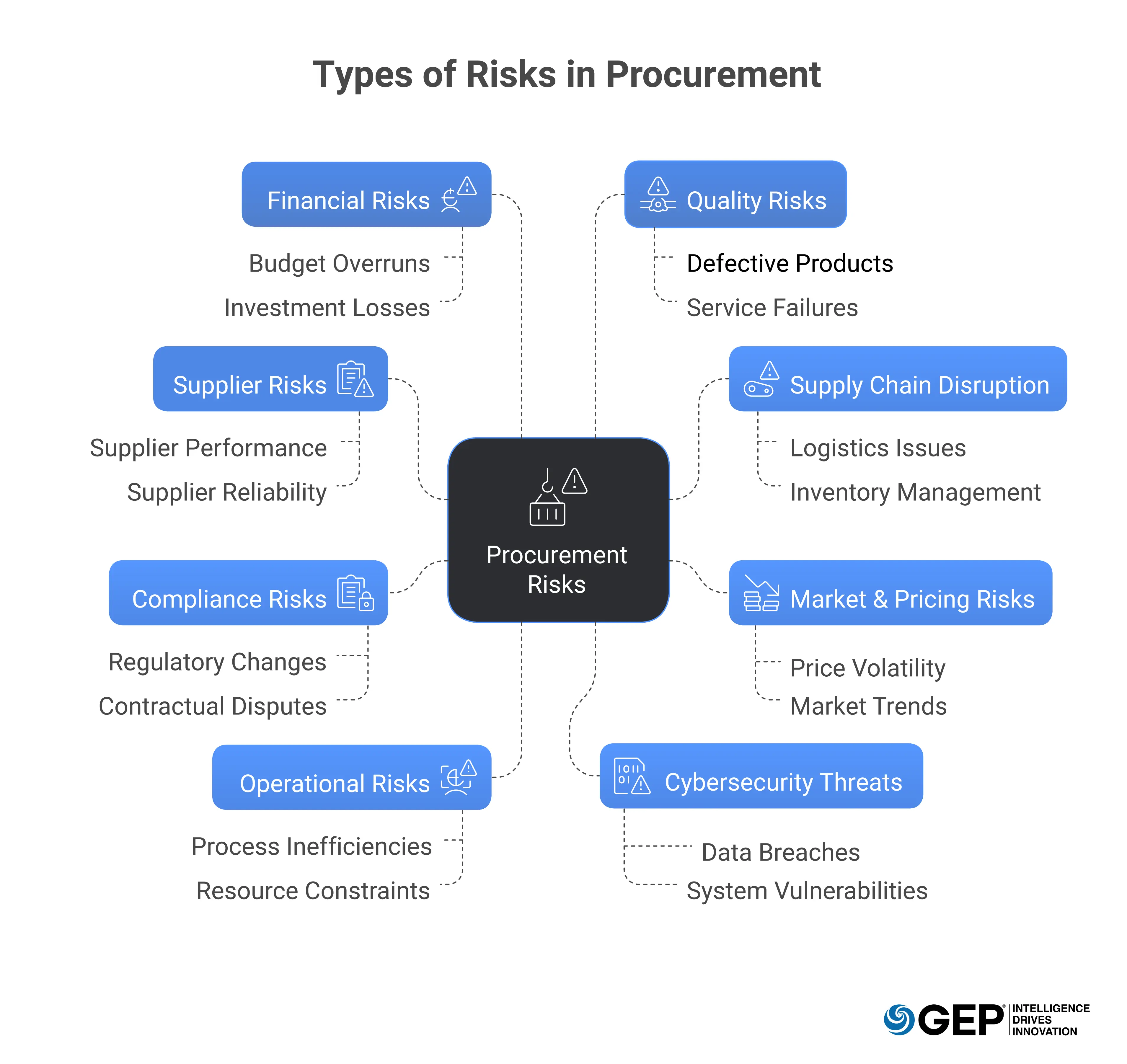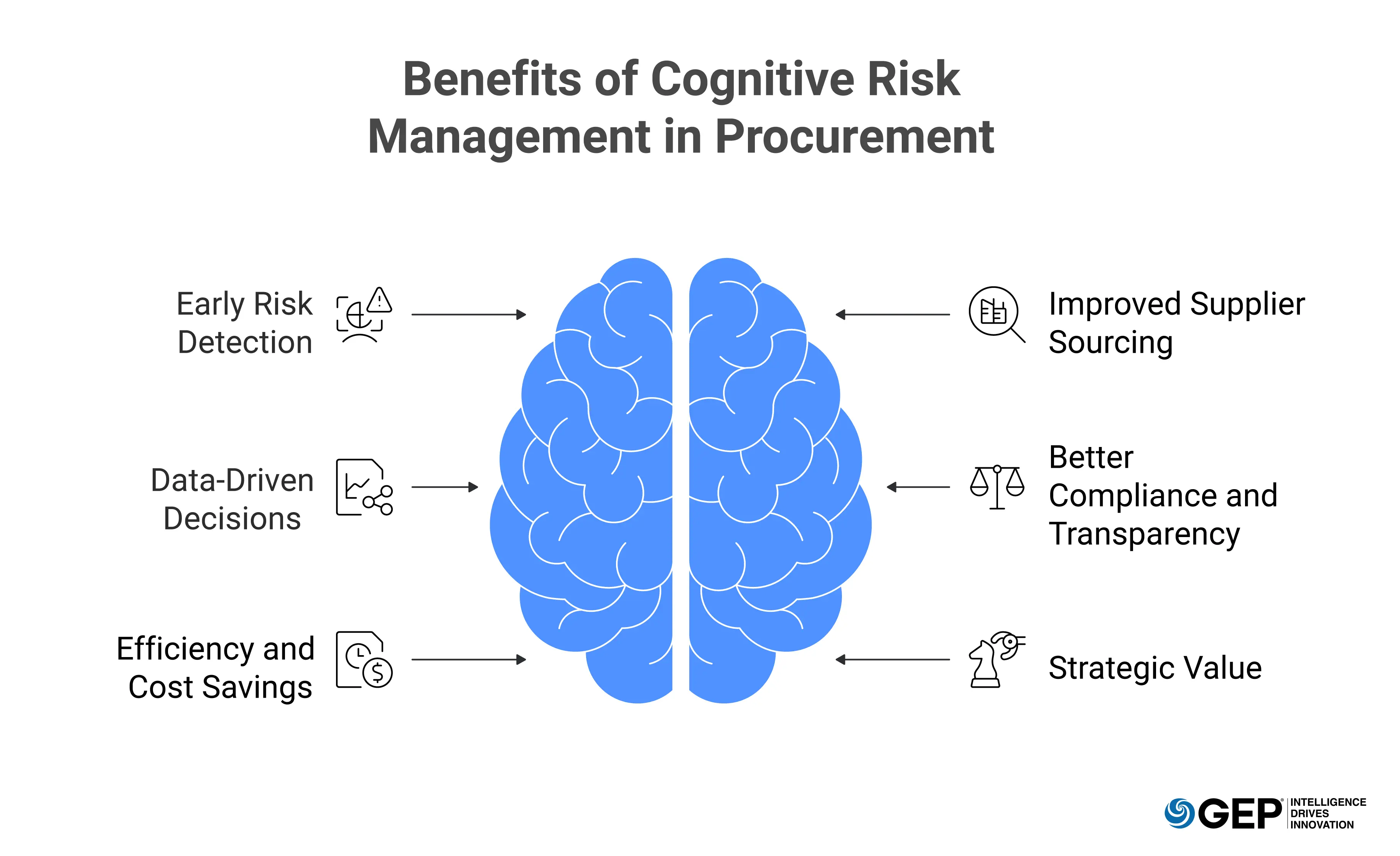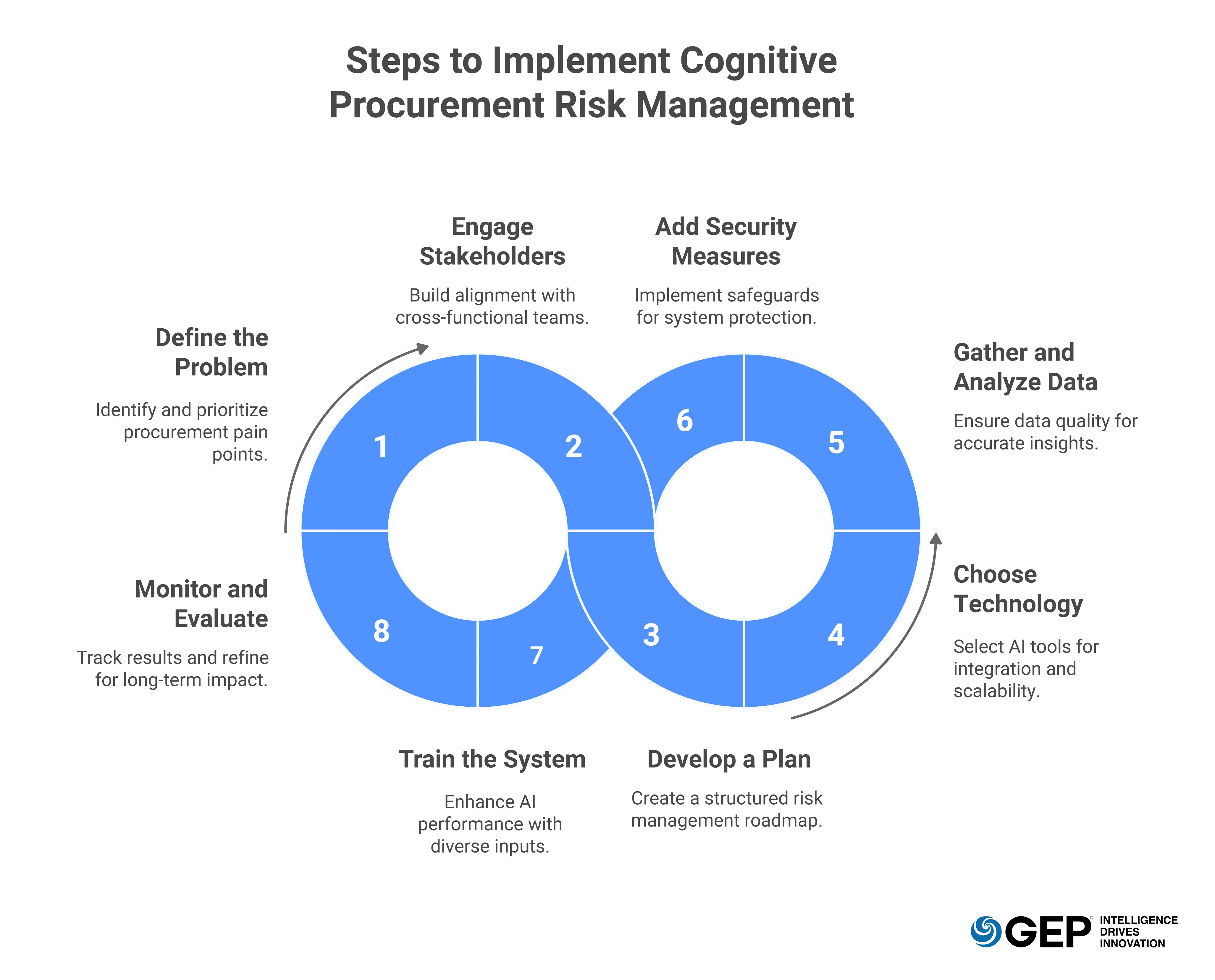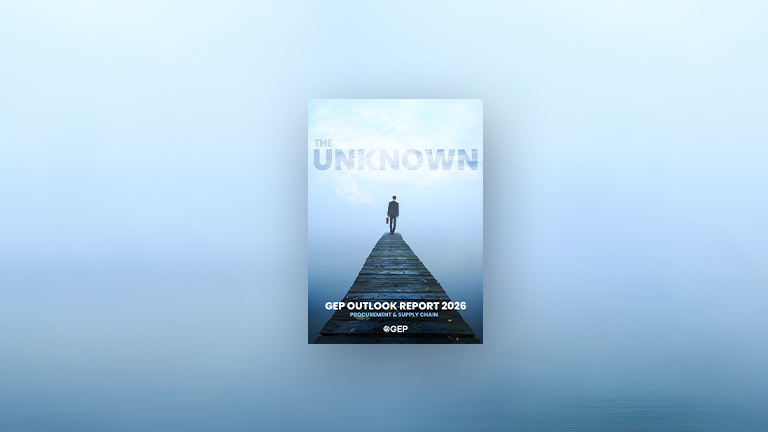
Catch Threats in Time with Cognitive Procurement Risk Management
- Traditional risk management fails when threats emerge fast.
- Cognitive systems combine AI, data, and automation to detect, analyze, and act on risks in real time.
- Successful adoption demands clear priorities, quality data, the right tech stack, and ongoing human oversight.
September 05, 2025 | Risk Management 6 minutes read
We’re in an age defined by rupture. Think about the last time disruption blindsided your team. What would you have given for just 30 days’ warning?
Today, it’s not enough to just react. You have to catch threats as they emerge.
So ask yourself: Can you pinpoint your biggest procurement risk in the next six months? In a world where the next threat is always a step ahead, foresight is everything.
A timely warning means you act, adapt, and protect your business when it needs it the most. That’s the promise of cognitive procurement risk management.
Talk to our experts
What Makes Procurement “Cognitive”?
Cognitive refers to the ability to perceive, interpret, reason, and learn.
Cognitive systems learn from data, reason through scenarios, and adapt over time. They enable organizations to uncover what others miss and act with foresight rather than hindsight.
Cognitive procurement risk management specifically targets risk identification and mitigation in procurement.
It is a multi-layered “intelligent nervous system” that continuously scans, predicts, and helps neutralize threats to supply chains by fusing big data, machine learning, and real-time analytics with human procurement expertise.
It's not just automation; it’s automation with intelligence. The more you use them, the smarter they get.
Agentic AI in procurement is an excellent example of cognitive capability in action. The system thrives on high-volume, multi-modal data. Unlike traditional automation, it doesn’t wait for instructions or follow typical rules but thinks strategically, learns from experiences, and acts autonomously, involving humans only when necessary.
Types of Risks in Procurement

When you’re running a business, you always have to be vigilant. Supply chains can unravel overnight, markets can flip with a single headline, and what worked yesterday won’t protect you tomorrow.
Here are the types of procurement risks to look out for:
1. Supplier Risks
It happens more often than you think. Are you relying on just one or only a few suppliers? If your supplier doesn’t deliver, delivers late, or sends you bad quality, you’ve got a problem. Track performance metrics, tighten up your processes, and ensure fair play.
2. Supply Chain Disruption
It could be anything. Storms, strikes, or sudden events can stop supplies from getting through. But if you’re proactive, you can spot it, fix it, and keep things moving.
3. Pricing and Market Risks
Geopolitical instability, trade barriers, commodity price shocks, and inflation volatility make forecasting a real challenge. If you’re not watching closely, costs can spiral fast.
4. Compliance and Legal Risks
Regulations and standards matter. Bad contracts lead to disputes and losses, and non-compliance can wreck your reputation. Monitor for potential fraud and compliance with labor, environmental, and other regulatory standards.
5. Operational Risks
Even small mistakes and inefficiencies can disrupt the supply chain, slow operations down, and cost money. Tighten up your processes and make sure everyone knows the playbook.
6. Cybersecurity and Data Risk
Hackers are out there, always looking for a way in. A single breach can cost you more than just money. Invest in strong security to keep your business and your customers safe.
7. Financial Risks
If you lose track of your budget or cash flow, you’re sunk. Rogue spending, payment errors, or missed invoices can hurt your bottom line. Strong controls and real-time oversight make all the difference.
8. Quality Risks
If your goods or services aren’t up to standard, you lose twice: with your customers and your brand reputation. Set the bar high and keep checking. Don’t let quality slip.
The pace and complexity of procurement risk are accelerating, and traditional methods can’t keep up. Global procurement leaders must adopt cognitive procurement risk management to spot trouble early, adjust quickly, and keep the business on track.
The Truth About AI in Procurement: A Reality Check
Data from GEP’s ProcureCon Report shows what’s hype and what’s reality.
Key Technologies Powering Cognitive Procurement Risk Management
When you know how all the systems connect, where there are interdependencies, risks, and bottlenecks, you stay ahead of the problems, helping you plan better and avoid surprises.
Artificial Intelligence and Machine Learning (ML)
They combine algorithms and workflows, take in all your procurement data, spot patterns, and learn from every purchase, delay, and disruption. Understanding what these technologies can and cannot do helps you set realistic expectations, ask thoughtful questions, and make informed decisions for real impact.
Predictive Analytics
Predictive analytics pulls in trends from everywhere, including markets, supply chains, and global headlines. It forecasts risks by combining real-time and historical data, giving you precious time to adapt your playbook before issues hit.
Natural Language Processing (NLP)
NLP gives your tech the gift of language. NLP easily integrates with voice assistants, search engines, and other technologies to access anything on the web. It reads emails, contracts, social posts, and ESG reports and finds red flags, whether buried in legal fine print or a news article worldwide.
Procurement Automation
Once risk is detected, cognitive platforms automate routine actions: sending alerts, pausing orders, rerouting supply, or chasing compliance gaps. This gives your teams time to think strategically and work on priority tasks, leaving routine tasks to automation.
Cloud-Based Platforms
Cloud technology gives you scale and flexibility. Your procurement team gets real-time access to tools and insights, collaboration is seamless wherever your team sits, and scaling up is instant.
These technologies work together and deliver actionable insights, making resilience and efficiency a primary part of your business.
How Can Procurement Leaders Benefit from Cognitive Risk Management?
Adopting a cognitive approach to procurement risk management offers several advantages:

- Early risk detection that warns you before the problem hits.
- Improve supplier sourcing by evaluating suppliers based on pre-defined metrics.
- Data-driven decisions remove guesswork and allow for confident data decisions.
- Better compliance and transparency help you avoid surprises and fines, and build trust.
- Efficiency and cost savings automations that boost productivity and save money.
- Strategic value puts you in control and keeps you ahead of the competition.
With smart tech and real-time data, you cut out the guesswork, negotiate the best deals, and make procurement a strategic function.
Steps to Implement Cognitive Procurement Risk Management Correctly
Even the most advanced tools and AI models won’t deliver meaningful results without the right approach. If you’re a procurement leader, here’s a step-by-step process to guide you through a successful implementation:

1. Define the Problem
Start by knowing your pain points. Use data-driven insights to understand what’s holding you back. List them down and prioritize what will impact your business the most. Find problems that recur, get ignored, or hide within a complex supply chain or technical incapabilities.
2. Engage Stakeholders
The more perspectives you bring in, the more precise the picture. Involve key stakeholders early on. Risks can come from any corner. Get your procurement, finance, compliance teams, and external partners on board and engaged. Build a culture where tools, learning, and shared ownership drive improvement.
3. Develop a Risk Management Plan
Gather insights from your risk assessment survey and create a detailed plan that outlines your goals and strategies for managing each identified risk. Develop a roadmap outlining the necessary steps, timelines, and resources.
4. Choose the Right Technology
Don’t settle for second best. Invest in world-class tech and make sure it serves you. It must deliver results, integrate smoothly with your existing systems, be simple to use, and adapt as your needs grow. Discuss your existing procurement risks and risk management strategies to develop and communicate clear policies and guidelines with your technology partner.
5. Gather Data and Analyze Data
To experience cognitive procurement at its best, you need great data. If your information is bad, you’ll get inaccurate predictions. Cognitive AI thrives on rich, diverse data. The clearer (and broader) your information, the more powerful and accurate your risk insights will be.
Tip: Ensure data quality via data validation, cleansing, and encryption. Also, check for data format compatibility issues and adopt standardized data formats for easy integration with other software and data sources.
6. Add Security Measures
Protect your business against data breaches or cyber attacks by using role—or account-based access controls, implementing data encryption, and having a disaster recovery plan. Regularly train your team to use safe cybersecurity practices.
7. Train the System
Get your AI smart—fast. Feed it with real scenarios and past risk events unique to your business. Bring in your experts, their intuition, and all your available data. To avoid data bias and ensure fairness, use bias detection tools, train models on diverse and representative data, and regularly audit algorithms.
8. Monitor and Evaluate
Track performance, get feedback, and measure impact. If it isn’t performing, implement processes to refine, retrain, and improve. Accountability and regular reflection ensure your procurement risk management software delivers real business value.
Conclusion
If you want true supply chain resilience, ask yourself: "What's the biggest procurement risk I can't see right now?"
Procurement requires strategy, innovation, and the right tech stack. With cognitive procurement risk management, you're designing a supply chain that learns, adapts, and leads. But let’s be honest. It will not work without good data, the right tech partner, and a team ready to pivot fast.
Ready to future-proof procurement with cognitive risk management? Request a demo of GEP SMART today.



